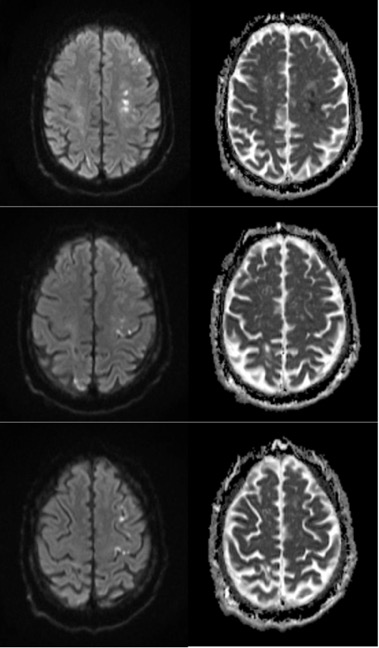Session Information
Date: Wednesday, September 25, 2019
Session Title: Phenomenology and Clinical Assessment of Movement Disorders
Session Time: 1:15pm-2:45pm
Location: Les Muses Terrace, Level 3
Objective: We describe a case of a patient with an acute stroke who presented with abnormal posturing and tremulous movements of the right upper extremity, which was thought to be a dystonic tremor but turned out to be simple partial status epilepticus.
Background: The timing of onset of abnormal movements post-stroke helps in the classification and appropriate diagnosis. Abnormal movements develop as residual complications in 1–4% of all patients after strokes. The latency between the acute stroke and the onset of abnormal movement varies from less than a day to several years after the event. Dystonia usually arises a few weeks to years after a stroke. The frequency of early post-ischemic seizures ranges from 2 to 33%; 50 to 90% appear to be simple partial seizures.
Method: A 61-year-old man newly diagnosed with hypertension, developed numbness and weakness in the right upper extremity. Within hours, he developed abnormal posturing of the right hand, finger splaying, and non-distractible, jerky, tremulous movement which is present at rest, posture and action, and resolved in his sleep. There was no alteration in mentation. Movement disorders team was consulted for possible acute dystonic tremor.
Results: A routine EEG was normal (and the movements were captured). Diffusion Weighted and Apparent Diffusion Coefficient MRI demonstrated several small embolic-appearing infarcts in the left frontal region (Figure 1). Despite dystonic features on the exam, the development of post-stroke dystonia has never been described, and the temporal sequence of events raised high suspicion for simple partial status epilepticus. A mild improvement occurred with a single dose of lorazepam. The patient was then given a valproic acid loading dose (15 mg/kg) and continued on valproic acid 500 mg BID. While driving home on the day of discharge his abnormal movements resolved. His valproic acid was tapered over the following week, and he remained asymptomatic at four days and six months follow-up.
Conclusion: Dystonia, the second most common post-stroke movement disorder is typically delayed in onset. There should be a high suspicion for simple partial seizures, where there is an acute onset of movements post-stroke, even when the EEG is normal. Simple partial seizures can resolve in sleep.
References: Scott BL, Jankovic J. Delayed-onset progressive movement disorders after static brain lesions. Neurology. 1996;46(1):68-74. Camilo O, Goldstein LB. Seizures and epilepsy after ischemic stroke. Stroke. 2004;35(7):1769-75.
To cite this abstract in AMA style:
T. Ali, S. Pradeep, D. Ginupally, Z. Guduru. Simple Partial Status Epilepticus Presenting With Dystonic Features In Acute Stroke [abstract]. Mov Disord. 2019; 34 (suppl 2). https://www.mdsabstracts.org/abstract/simple-partial-status-epilepticus-presenting-with-dystonic-features-in-acute-stroke/. Accessed April 2, 2025.« Back to 2019 International Congress
MDS Abstracts - https://www.mdsabstracts.org/abstract/simple-partial-status-epilepticus-presenting-with-dystonic-features-in-acute-stroke/

